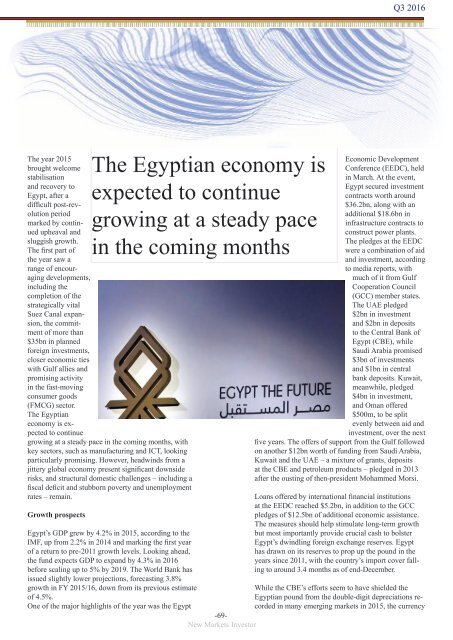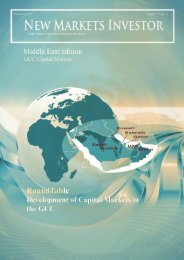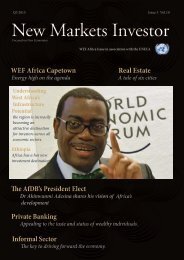Q4 2018 New Markets Investor
The magazine targets an audience of corporate and private investors, but its lucid voice makes it intelligible and essential reading for anybody who wants to understand investment strategies and markets in the 21st century.
The magazine targets an audience of corporate and private investors, but its lucid voice makes it intelligible and essential reading for anybody who wants to understand investment strategies and markets in the 21st century.
You also want an ePaper? Increase the reach of your titles
YUMPU automatically turns print PDFs into web optimized ePapers that Google loves.
Q3 2016<br />
The year 2015<br />
brought welcome<br />
stabilisation<br />
and recovery to<br />
Egypt, after a<br />
difficult post-revolution<br />
period<br />
marked by continued<br />
upheaval and<br />
sluggish growth.<br />
The first part of<br />
the year saw a<br />
range of encouraging<br />
developments,<br />
including the<br />
completion of the<br />
strategically vital<br />
Suez Canal expansion,<br />
the commitment<br />
of more than<br />
$35bn in planned<br />
foreign investments,<br />
closer economic ties<br />
with Gulf allies and<br />
promising activity<br />
in the fast-moving<br />
consumer goods<br />
(FMCG) sector.<br />
The Egyptian<br />
economy is expected<br />
to continue<br />
growing at a steady pace in the coming months, with<br />
key sectors, such as manufacturing and ICT, looking<br />
particularly promising. However, headwinds from a<br />
jittery global economy present significant downside<br />
risks, and structural domestic challenges – including a<br />
fiscal deficit and stubborn poverty and unemployment<br />
rates – remain.<br />
Growth prospects<br />
The Egyptian economy is<br />
expected to continue<br />
growing at a steady pace<br />
in the coming months<br />
Egypt’s GDP grew by 4.2% in 2015, according to the<br />
IMF, up from 2.2% in 2014 and marking the first year<br />
of a return to pre-2011 growth levels. Looking ahead,<br />
the fund expects GDP to expand by 4.3% in 2016<br />
before scaling up to 5% by 2019. The World Bank has<br />
issued slightly lower projections, forecasting 3.8%<br />
growth in FY 2015/16, down from its previous estimate<br />
of 4.5%.<br />
One of the major highlights of the year was the Egypt<br />
-69-<br />
<strong>New</strong> <strong>Markets</strong> <strong>Investor</strong><br />
Economic Development<br />
Conference (EEDC), held<br />
in March. At the event,<br />
Egypt secured investment<br />
contracts worth around<br />
$36.2bn, along with an<br />
additional $18.6bn in<br />
infrastructure contracts to<br />
construct power plants.<br />
The pledges at the EEDC<br />
were a combination of aid<br />
and investment, according<br />
to media reports, with<br />
much of it from Gulf<br />
Cooperation Council<br />
(GCC) member states.<br />
The UAE pledged<br />
$2bn in investment<br />
and $2bn in deposits<br />
to the Central Bank of<br />
Egypt (CBE), while<br />
Saudi Arabia promised<br />
$3bn of investments<br />
and $1bn in central<br />
bank deposits. Kuwait,<br />
meanwhile, pledged<br />
$4bn in investment,<br />
and Oman offered<br />
$500m, to be split<br />
evenly between aid and<br />
investment, over the next<br />
five years. The offers of support from the Gulf followed<br />
on another $12bn worth of funding from Saudi Arabia,<br />
Kuwait and the UAE – a mixture of grants, deposits<br />
at the CBE and petroleum products – pledged in 2013<br />
after the ousting of then-president Mohammed Morsi.<br />
Loans offered by international financial institutions<br />
at the EEDC reached $5.2bn, in addition to the GCC<br />
pledges of $12.5bn of additional economic assistance.<br />
The measures should help stimulate long-term growth<br />
but most importantly provide crucial cash to bolster<br />
Egypt’s dwindling foreign exchange reserves. Egypt<br />
has drawn on its reserves to prop up the pound in the<br />
years since 2011, with the country’s import cover falling<br />
to around 3.4 months as of end-December.<br />
While the CBE’s efforts seem to have shielded the<br />
Egyptian pound from the double-digit depreciations recorded<br />
in many emerging markets in 2015, the currency









